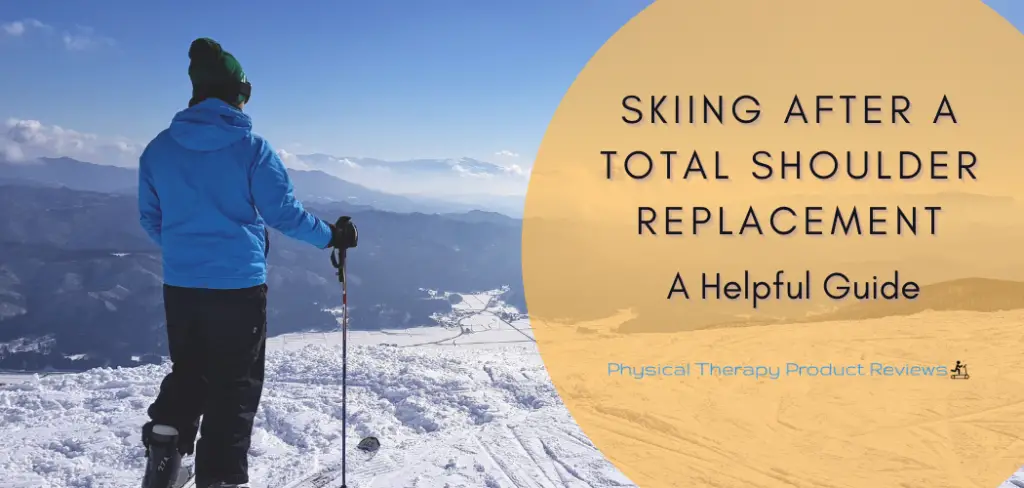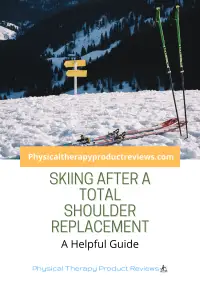 A total shoulder replacement isn’t a moratorium on fun! When it comes to skiing after a shoulder work up, you can still enjoy the snow safely.
A total shoulder replacement isn’t a moratorium on fun! When it comes to skiing after a shoulder work up, you can still enjoy the snow safely.
Before you strap on the goggles, there are a few things to know. Use this article as a guide to help you return to skiing after you’ve had a shoulder replacement.
Is Skiing After a Total Shoulder Replacement Safe?
With a guided and gradual rehabilitation program focused on the return of strength and mobility, a total shoulder replacement patient can expect to return to recreational skiing.
Patients with a total shoulder arthroplasty versus those with a reverse total shoulder arthroplasty, typically have more success returning to the sport. Research shows us that if you participated in skiing before your shoulder surgery, you have a high likelihood of a successful return to skiing!
How Long Should You Wait After Surgery Before Skiing?
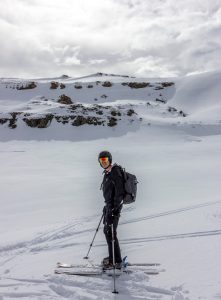 Most patients are able to return to full participation in skiing by about 6 months post-op. It’s best to wait until you get an official thumbs-up from your surgeon or physical therapist before getting back into the sport.
Most patients are able to return to full participation in skiing by about 6 months post-op. It’s best to wait until you get an official thumbs-up from your surgeon or physical therapist before getting back into the sport.
Your physical therapist will test your strength, range of motion, and functional abilities before clearing you to return to skiing.
Modifications To Make While Skiing
Even if you were a mogul maverick before your shoulder injury, it’s best to start green and work your way up. Stick to the groomed runs and keep things smooth and easy to begin with.
You can advance to more difficult terrain and off-piste slopes in due time! Your first season back on the mountain should be considered a warm-up for your season next year.
Pay Attention To Your Poles
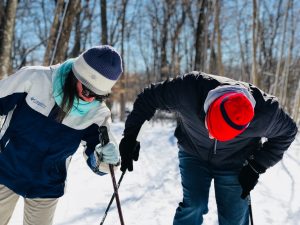 They are your third point of contact with the ground, help you keep balance, turn, and improve your stability.
They are your third point of contact with the ground, help you keep balance, turn, and improve your stability.
Remember that your pole length should allow your elbow to be at a 90-degree angle.
It might be helpful to revisit newbie territory and ask an instructor to oversee your pole technique to offer suggestions.
Learn To Fall - The Safe Way
Realistically, skiing does involve a high fall risk. For this reason, it’s important to understand how to fall safely to avoid injuring your shoulder.
Use these key points to protect your arm from further injury during a ski fall:
- Relax. Don’t fight that fall! Avoid tensing your body when you are falling. Yes, it’s difficult to do, but tensed muscles are more likely to injure during a fall.
- Don’t reach your arm out. It’s instinct to want to catch yourself when you fall, but that act puts your shoulder at high risk for injury. Instead, attempt to body roll.
Skiing After A Total Shoulder Replacement
Exercises To Prepare Your Shoulders for Skiing
Your successful rehabilitation after a total shoulder replacement is essentially your Lift Pass! You just can’t ski without it. Add in the exercises below to keep your shoulder game strong as you prepare for the season.
Plank Progression
- Assume a plank position (or begin on your forearms).
- Keep your body in a rigid line and don’t hunch your shoulders.
- Hold for 30 seconds and repeat 5x.
- Continue to expand the amount of time you hold the plank.
- Make this exercise harder by lifting one leg at a time, or one arm at a time.
Cable Pulls
- Attach a cable at ankle level to a sturdy anchor – like a doorway or table leg.
- Step to the side and grasp the cable with both hands.
- Keeping your elbows straight, rotate your arms diagonally up and away from the cable anchor, then return them to the start, in a wood chopping-like motion.
- Complete 15 reps and repeat for 3 sets.
- Next, attach the cable to an overhead position and repeat this motion in the opposite direction.
Lateral Raises
- While standing, hold on to a long cable and step on the other end to keep it secured.
- Keeping your elbow slightly bent, raise your arm out to the side until it comes to about shoulder level.
- Return to start with control.
- Complete 15 reps and repeat for 3 sets.
Tips for Returning to Skiing After a Total Shoulder Replacement
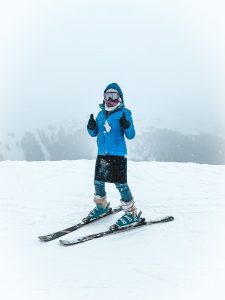 Consider the following equipment when you are reading yourself for the slopes.
Consider the following equipment when you are reading yourself for the slopes.
- Braces: a fitted neoprene shoulder brace can help provide some external stability to your shoulder and a bit of protection in case of a fall. Just make sure it doesn’t limit your motion.
- Poles: aim for a pole made from sturdy material like aluminum. The weight should be light to allow easy motion but strong to eliminate bending. Also, opt for a quick-release strap. This can help prevent injury in case of a fall.
- Taping: you can try out some kinesiotape techniques for your shoulder girdle to improve your joint awareness and proprioception.
Conclusion
Returning to skiing after a shoulder replacement is very possible for patients that were skiers before their surgery. Take care in advancing back into your sport and you’ll have many years of powder, slush, and snow ahead of you.
References:
Ghosy S, et al. Efficacy of Kinesio taping in treatment of shoulder pain and disability: a systematic review and meta-analysis of randomized controlled trials. Physiotherapy. 2020; 1-7: 176-188. https://www.sciencedirect.com/science/article/abs/pii/S0031940619301270
How to train for skiing. REI. https://www.rei.com/learn/expert-advice/how-to-train-for-skiing.html
Johnson CC, Johnson DJ, Liu JN, Dines DM, Gulotta LV, Garcia GH. Return to sports after shoulder arthroplasty. World Journal of Orthopedics. 2016; 7(9):519-526. https://www.ncbi.nlm.nih.gov/pmc/articles/PMC5027006/
What ski poles are for and how to use them properly. Snow Magazine. 2019. https://www.snowmagazine.com/features/skills/what-ski-poles-are-for-and-how-to-use-them-properly
Wong M. How to fall right. Outside Online. 2013. https://www.outsideonline.com/health/training-performance/how-fall-right/
Other Great Rehab Related Articles
How to Stay Active After Cervical Fractures: Expert Tips and Advice
Dealing with Painful Stairs After Ankle Replacement Surgery
Walking After a Total Ankle Replacement: Tips for a Successful Recovery
Exercises While Non-Weight Bearing After Ankle Replacement: Elevation, AROM, Leg Raises, and More
Ankle Pain with Stairs: Causes and Home Treatment Options
5 Common Mistakes You’re Making After an Ankle Sprain
Disclaimer: The information provided in this post is for educational purposes only. This is not a substitute for a medical appointment. Please refer to your physician before starting any exercise program.
